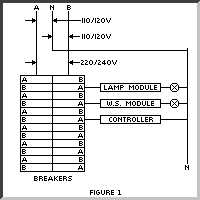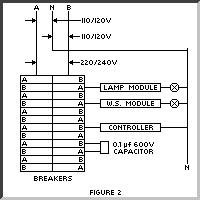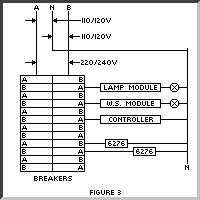Troubleshooting Lighting Controls
Some Modules Don't Respond
The most commonly encountered problem with systems which use the existing house wiring to transmit signals is the signals are received by some Receiver modules, but not by others. For example, the Controller controls some lights but not others or controls some lights intermittently. This can happen sometimes when the Module to be controlled is on the opposite phase of the house wiring to the phase which the Controller is connected to.
Phases in household wiring is caused by two different power currents running from the electrical breaker box. (see figure 1). It is, therefore, suggested that the Controller and all Modules to be controlled by that Controller be on the same phase. This can be accomplished by reviewing your breaker panel (see figure 1 - "N" is X10 units on "B" phase) Where it is not possible, the problem can be solved by fitting a coupling capacitor (also known as a phase coupler or signal bridge) across the two phases of the house wiring to couple the signal from one phase to the other.
Phase coupling
In most cases the signals transmitted by the Controller will control any Module plugged in anywhere in the house. The signal level transmitted is usually in the order or 4 to 5 volts but varies with line impedance and loading (Controller plugged in next to a TV set, for example.) However, the amplitude of signal required to operate a module is only 50 millivolts (0.05 volts) so there is enough tolerance in the transmit/receive ratio to allow for considerable signal attenuation. Most signal attenuation occurs when the signal has to "jump the phases".
Most houses are wired such that 220v (240V) is brought into the breaker panel and then split into 2 phases of 110v ( 120V) each. The signals from the Controller are transmitted onto one phase and have to travel all the way out to the pole transformer to couple across to the other phase. The amplitude of signal on the "other" phase can, therefore, be greatly reduced.
Signals can be "coupled" to the other phase by installing a 0.1 microfarad (0.1µF), 600VDC capacitor across the two phases in the panel, i.e. by connecting the capacitor across any 220V breaker (see Figure 2)
Modules turn on/off by themselves
If it is suspected that Modules have turned on by themselves, the first step should be to change the Housecode on the Controller and all of the Modules. It is possible that a neighbor has the same system or another compatible system. If both houses are on the same pole transformer, it is possible for signals to couple from one house to another.
If the problem persists, it is possible that the Controller of the Modules have been triggered by a "spike" on the power line. Although this should be a rare occurrence it may help to fit a filter on each phase in the breaker panel, The 6276 (available from Leviton Manufacturing Co.) is a filter which also contains a "spike suppresser" or M.O.V. (Metal Oxide Varistor). See Figure 3.
It is suggested that a 6276 be installed on both phases, but if the controller and all the Modules are on the same phase, one 6276 on that phase may be sufficient.
If Modules turn on unpredictably, it is also possible that the modules may have been triggered by a 120V AC power "dip" or "brown out". Lamp Modules and Appliance Modules have a feature called "local control". This feature lets you turn the Module on by turning the power switch on the light or appliance off and then on again. There is a circuit in the Module which detects this change in load and interprets it as a request to turn on. This "local control" circuit by design is very sensitive. Therefore it can sometimes change in the load, and "think" it has been told to turn on. If this problem is suspected, it is recommended that the local control feature be disabled.
Disabling the local control feature
It is possible to disable the local control feature of the Appliance Module by plugging a "cube tap" into the Module then two items can be plugged into the same Module. Plug a 7 1/2 watt night light into one of the receptacles of the cube tap and the appliance you want to control into the other. When the Module is on, the appliance and night light will be on. When the Module is off, the appliance and the night light will be off. Now, even if you operate the power switch on the appliance, the night light is always "in circuit" so the Appliance Module's local control circuit is disabled.
Other Sources of Line Noise
Certain brands of TVs can generate noise and superimpose it on the power line. In most cases, this kind of noise will not cause a problem. If, however, it is determined that the TV is causing a problem (which can be determined by unplugging the TV to see if the problem goes away) it is suggested that the TV be plugged into a filter to isolate it from the AC line. The kind of filter used to protect a TV from interference from heavy applications like power drills is recommended ( Cat.# 15-1111 from radio shack for example). This filter may help to isolate the load (or internal capacitance) of the TV from the AC line if it is found that the TV is attenuating the signals from your Controller(s).
Wireless Intercoms
Intercom systems which use the house wiring to transmit can "block out" X10 transmissions while the intercom is left in the permanent transmit (talk) mode. Unfortunately there is no simple solution to this problem. If the Controller and all the Modules are on one phase the first thing to try would be to change them all to the other phase. It has been found that the 6276 filter can in some cases attenuate signals from a neighbor's intercom sufficiently enough to allow the Controller's signals to be received by the X10 Modules. It is NOT possible to have a wireless intercom and a Controller operating in the same house. Figure 3 shows how the 6276 should be connected. .
SOME DON'Ts
- DON'T Use a Wall Switch Module to control a Fluorescent light, a fan, or any kind of appliance. This could cause damage to the Module and/or the light/appliance. (Do - get Appliance modules for appliances.)
- DON'T Use a Wall Switch Module to control an outlet unless you are sure no one will plug an appliance ( a vacuum cleaner for example) into the outlet. See above.
- DON'T Use a Lamp Module to control a fluorescent light, a fan, or any kind of appliance.
- DON'T Use a Lamp Module or a Wall Switch Module to control a lamp or fixture which already has a dimmer on it. (3-way OK if not over 300 watts)
- DON'T Use a module to control something which would be dangerous if it were turned on turned on remotely while unattended (e.g. an empty coffee pot, an electric fan with poorly protected blades, or a space heater.)
- DON'T use a Wall Switch Module for lamps less than 60 watts.
- DON'T leave a wireless intercom or baby monitor in the permanent transmit (or talk) mode. Its transmissions could "block out" X10 transmissions.
- DON'T exceed the rating of the modules, these are:
Lamp Module - 300 watts incandescent only.
Wall Switch Module - 500 watts incandescent only.
Appliance Module - Appliances rated 15A Resistive (such as coffee pots and heaters) OR 1/3 H.P. motor load OR 400 watts for TV sets OR 500 watts for lamps, because of the "inrush current" from a cold lamp.


